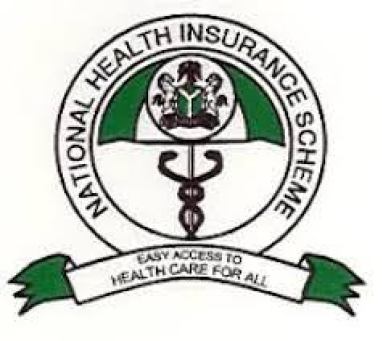0UTLINE ON HEALTH CARE FINANCING (HCF) AND NHIS
- Introduction
- Goals of HCF strategies
- Mechanisms of health care financing
1. Funding mechanisms
2. Payment mechanisms
3. NHIS- National Health Insurance Scheme
- Programmes
- Financing
- Scope of coverage
- Benefit package
- Exclusions
- Conclusion
References
LIST OF ABBREVIATIONS
- GDP: Gross Domestic Product
- HCF: Health Care Financing
- NHIS: National Health Insurance Scheme
- PHC :Primary Health Care
- SHI: Social Health Insurance
- VAT: Value Added Tax
- WHO: World Health Organization
DEFINITION OF TERMS
• Care: the provision of what is necessary for health, welfare, maintenance, and protection of someone or something
• Finance: Deals with resource allocation, management and acquisition
• Health: a state of physical, social and mental wellbeing and not merely the absence of disease
• Health care financing: mobilization of funds for health care, allocation of funds to the regions and population groups and for specific types of health care and the mechanisms for paying health care
• Insurance: a defined contribution linked to a defined package of benefits for a specific period of time
• Premium: the amount of money to be charged for a certain amount of insurance coverage
• Primary Health Care: essential health care based on practical, scientifically sound and socially acceptable methods and technology made universally acceptable to individuals and families in the community through their full participation and at a cost the community and country can afford to maintain at every stage of their development in the spirit of self reliance and self determination
• Tax: an involuntary fee levied on corporations or individuals that is enforced by a level of government in order to finance government activity

INTRODUCTION
This topic consists of 3 main terms
• Health
• Care
• Financing
Understanding this concept forms the basis for link between these 3 words fully understanding the topic.
• “ health is wealth”
• In 2001 approximately 9 percent of global gross domestic product (GDP) was spent on health care worldwide
• seventy countries devote less than 10% of general government expenditure to health
• Health financing provides the resources and economic incentives for the operation of health systems and is a key determinant of health system performance in terms of equity, efficiency and health outcomes.
• It an essential ingredient in the growth and development of any nation. It provides the basis for the health of a nation and livelihood for health personnel.
• One of the major problems of PHC in Nigeria is poor financing (WHO, 2009)
• There are 3 basic functions of health financing
1. Collecting revenues
2. Pooling resources
3. Purchasing services
GOALS OF GOOD HEALTHCARE FINANCING
• Ensure that healthcare is affordable and of high quality
• Ensure that essential health care goods and services are adequately provided for
• Achieve equity and efficiency in the use of health care spending
• Mobilize resources for health care
• Ensure that money is spent wisely so that the MDGs could be achieved
• Ensure the payment for or purchase of health services is carried out in ways that are allocative and technically efficient
MECHANISMS OF HEALTH CARE FINANCING
Whether or not resources are efficiently used depends on the following mechanisms:
• The Funding mechanisms (sources)
• The Payment mechanisms
The funding mechanisms could be:
• External sources
• Internal sources: these could also be
1. Public sources
2. Private sources
Public funds
The government is usually responsible for the generation of public funds.
The public funds include the following:
• Social insurance
• General tax revenue
• Deficit financing
• Lotteries and betting
• Sales tax revenue (earmarked taxes)
1. GENERAL TAX REVENUE:
• This is basically income gained by governments through taxation
• Unallocated funds acquired through business and property taxation
• Used for a variety of activities as detrmined by the state or local governments.
• An advantage is that it is equitable but then health sector competes with others.
Private funds
Voluntary payments made by individuals or employers and they include:
• Out of pocket payments
• Employer financed scheme
• Charity and voluntary contributions
• Private health insurance
• Community financing and self help
Out of pocket payments:
• Direct payments made by patients for medical services and they include:
1. Deductibles for doctor visits and prescription medications
2. User fees
3. Unofficial or informal payments
4. Payment for tests not available in health facility
Most common source of health care financing and is capable of causing households to incur catastrophic expenditures and tilt a patient to poverty.
• User fee was introduced by the Nigerian government under the Bamako Initiative in 1998 and it advocated for cost sharing and community participation to increase the sustainability and quality of health care.
• It may cause excessive spending, there is also no risk pooling and it is the least equitable. (Limwattananon, 2007)
Social Health Insurance:
• It is one of the possible organisational mechanisms for raising and pooling funds to finance health services
• It provides a pool of funds to cover the cost of health care and it also has a social equity function which eliminates barriers to obtaining health care services at the time of need especially for the vulnerable groups.
• A percentage of every individual’s wage is usually contributed. This is called premium.
• These contributions could be made:
1. Individually
2. By employers
3. By the government
• There are specified benefits by law.
Private Health Insurance:
• These is privately purchased insurance and it can be made by individuals or groups
• There is usually a high premium and it is expensive depending on the type of health plan purchased from the insurance company
• One of the main disadvantages is that it has complex regulations but an advantage is its ability to provide good comfortable health cover.
Community based health insurance:
• Families or family groups finance or co-finance costs of health services through locally based prepayment schemes
• Designed for individuals living in rural areas
• Increased amount of people brings increased dispute
• Decisions are reached at a slow pace most often
• the advantage is that the local control may bring more accountability and transparency
EXTERNAL SOURCE:
• Involves financial aid given to developing countries to support socioeconomic and health development
• Usually involves third world countries
• The various sources could be:
1. NGOs
2. Public-private partnerships 3. private foundations
Payment mechanisms
• Direct household payments
• Third party payments
1. Per diem: all inclusive rate for each day of hospital cost provided
2. Per admission: all inclusive flat rate for each hospital admission
3. Capitation- fixed fee paid to the provider for patient per month for each patient enrolled in practice
• Fee-for-service: charges made on itemized invoice.
• Contractual allowance: physicians normally bill on a fee for service basis but they actually take less than the billed amount. The discount that results is referred to as contractual allowance.
• Co-financing: predetermined percentage of health benefit cost is paid by the patient.
NATIONAL HEALTH INSURANCE SCHEME
INTRODUCTION
- The Nigerian National Health Insurance Scheme(NHIS) is an initiative planned to pool more resources to the health care sector and improve the level of access and utilization of health care services.
- Health insurance in Nigeria can be said to have undergone a prolonged incubation over the past five decades and a steady development in the last few years.
- This gave birth to the social health insurance scheme which went through a very tortuous planning process from 1962 until 1999 when the National health insurance scheme(NHIS) was established.
NATIONAL HEALTH INSURANCE SCHEME(NHIS)
- The national health insurance scheme was established in Nigeria by law number 35 of 1999 constitution and became operational in june, 2005.
- The scheme was aimed at improving health care delivery by providing a sustainable alternative source of funding health care services
- It is a social security arrangement that provides financial security to the citizens against unforeseen ill health.
PROGRAMMES
- In an attempt to make adequate health care available to all, the national health insurance scheme developed various programmes to cover different segments of the society and they include:
- Formal Sector Social Health Insurance Programme(FSSHIP):This consist of the public sector,organised private sector,armed forces,police and other uniformed services.
- Informal Sector Social Health Insurance Programme:This consist of community based social health insurance programme and voluntary contributors’ social health insurance programme.
- Vulnerable Group Social Health Insurance Programme:These are designed to provide health care services to persons who due to due to their physical status(including age) cannot engage in any meaningful economic activities eg physically challenged persons, children under 5, orphans, refugees, pregnant women, prison inmates and internally displaced persons.
- It is however important to note that most of all the current health insurance enrollees in Nigeria are on the formal sector social health insurance programme and are employees of the federal government.
FINANCING/CONTRIBUTIONS
- For the armed forces and other uniformed service men,contributions are fully paid for by the federal government and this equals 5% of participant’s salary.
- For the public(federal) sector programme, the employer pays 3.25% while the employee pays 1.75%, representing 5% of the employees salary.
- For the private sector programme and other tiers of government the employer pays 10% while the employee pays 5% representing 15% of the employees basic salary.
- The employer may however decide to pay the entire contribution
READ ALSO: Nigerian doctors least paid in the world-official
SCOPE OF COVERAGE OF NHIS
- The contribution paid cover healthcare benefits for the employee, a spouse and four biological children below the age of 18years.
- More dependants or a child above the age of 18 could be covered on the payment of additional contributions by the principal beneficiary.
BENEFIT PACKAGE OF NHIS
- Health care providers under the scheme are to provide the following services:
- Outpatient care, including necessary consumables.
- Prescribed drugs, pharmaceutical care and diagnostic tests as contained in the national essential drugs list and diagnostic test lists.
- Maternal care for up to four live births for every insured contributor in the formal sector.
- All new born eligible to cover will be covered during the postnatal period of twelve weeks from the date of delivery.
- Preventive care including immunization, health education and family planning education.
- Consultation with specialists such as paediatricians, dental surgeons etc
- Hospital care in a standard ward for a stay limited to cumulative 21 days per year following referral.
- Eye examination and care excluding spectacles and contact lenses.
- A range of prostheses (limited to artificial limbs produced in Nigeria).
- Preventive dental care including consultation, dental health education, amalgam filling and simple extraction.
- Family planning education only.
EXCLUSIONS FROM NHIS
Conditions and procedures excluded from the benefit of NHIS include:
- Occupational/industrial injuries
- Injuries resulting from natural disasters, social unrest and extreme sports
- Transplant and cosmetic surgeries
- Drug abuse/addition
- Epidemics
- Family planning commodities.
- Domiciliary treatment.
- Advanced procedures eg for complex congenital anomalies, artificial insemination and IVF.
- Postmortem examination (autopsy)
PARTIAL EXCLUSIONS FROM
- High technology investigations eg CT scan, MRI. Well, some HMOs now cover CT scan and MRI
- Dialysis for acute renal failure.
PAYMENT MECHANISMS OF NHIS
- Healthcare facilities under the NHIS may be paid by capitation, fee for service or per diem.
- For conditions on the partial exclusion list, the HMO and the enrollee pay (co-insurance).
- Enrollees will also be expected to pay 10% of the total cost of drugs dispensed per prescription(co-payment).
HOSPITALIZATION
- Enrollees in the NHIS are entitled to 21 cumulative days hospitalization in standard wards.
- The cost for the first 15days shall be borne by the primary healthcare facility while the remaining 6 days shall be borne by the HMO.
- In case of cerebrovascular accident (CVA or stroke) and orthopaedics, the enrollee is entitled to hospitalization in a standard ward for 6 cumulative weeks (42days).
CONCLUSION
- The Nigerian government employs various mechanisms for public health care financing system, however the health financing system is still characterized by low investment by the government, extensive out of pocket payments, limited insurance coverage and low donor funding.
- Thus, achieving the objectives of good health outcome, equity, patient and provider’s satisfaction is very challenging.
- However, there may still be a way forward for Nigeria.This will require strengthening the health care financing system.
- This system should ensure that everyone who requires health care services is able to access them and not denied due to inability to pay.
- Citizens must be able to benefit from at least one of the financing mechanisms in accessing health care services.
REFERENCES
• Babayemi OO. (2012).Public Health care financing in Nigeria:Which way forward?
• World Health Organization. (2015). Global Health Expenditure Database.

























have you got an email address to contact you on?
Yes. Contact me on [email protected]
Also check “about us” on the menu button.
Thank you